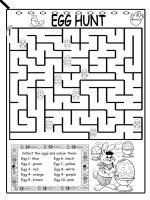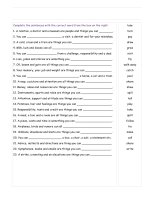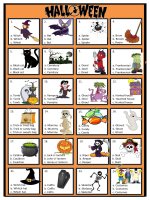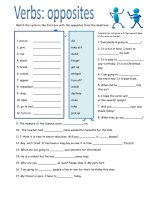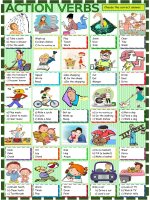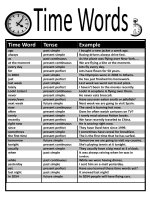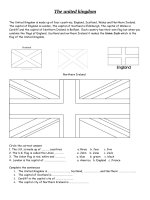students worksheets
Bạn đang xem bản rút gọn của tài liệu. Xem và tải ngay bản đầy đủ của tài liệu tại đây (1.22 MB, 72 trang )
Student’s
worksheets
CLIL
Music activities for optional subject
High School Level
Jazz
Cristina
Fuertes
IES Obert
de Catalunya
Cristina Fuertes. Institut Obert de Catalunya course 2007-08
CLIL – Student’s Worksheet Jazz Unit 1 What’s jazz?
Contents
CONTENTS................................................................................................................ 2
UNIT 1 WHAT’S JAZZ?.............................................................................................. 4
1. Starting point. What do you know about jazz? .................................................. 5
2. Jazz ................................................................................................................... 9
3. Feelings about jazz ......................................................................................... 10
4. What do you know now about jazz? ................................................................ 11
5. What’s jazz for you?........................................................................................ 12
6. Homework: search on the web ........................................................................ 13
UNIT 2 ELEMENTS OF JAZZ .................................................................................... 14
1.What’s jazz and what’s not .............................................................................. 15
2. Who or what am I? Jazz elements................................................................... 17
3. What does each instrument sound like? .......................................................... 20
4. What other instruments you can hear in jazz? ................................................ 21
5. Jazz bands....................................................................................................... 22
UNIT 3: THE ROOTS OF JAZZ .................................................................................. 23
1. Starting point Review of the previous Unit ...................................................... 24
2. Journeys into Jazz........................................................................................... 26
3. A word beginning with … ................................................................................ 27
4. Describe The dawn of the 20th century ............................................................ 28
5. Listen to early jazz .......................................................................................... 29
6. Work songs, field hollers, spirituals and gospels............................................. 30
7. Work song ....................................................................................................... 33
Cristina Fuertes. Institut Obert de Catalunya course 2007-08
2
Cristina Fuertes. Institut Obert de Catalunya course 2007-08
2
CLIL – Student’s Worksheet Jazz Unit 1 What’s jazz?
8. Ragtime........................................................................................................... 34
9. The blues......................................................................................................... 36
10. Scan the blues............................................................................................... 38
11. Marching bands ............................................................................................. 40
12. What would have had happened if there had been__? .................................. 43
UNIT 4 JAZZ UNTIL THE WORLD II WAR ................................................................ 44
1. The advent of Jazz .......................................................................................... 45
2 Jazz cities......................................................................................................... 46
3. New Orleans melting pot of sound (1910) ...................................................... 48
4. Dixieland jazz.................................................................................................. 51
5. Louis Armstrong.............................................................................................. 53
6. The Jazz Age Chicago (1920) .......................................................................... 55
7. Big band .......................................................................................................... 56
8. The swing: New York (1930)........................................................................... 59
9. Who is who ..................................................................................................... 61
10. The Duke ....................................................................................................... 64
GLOSSARY.............................................................................................................. 65
EXPRESSIONS FOR THE CLASSROOM ..................................................................... 71
Cristina Fuertes. Institut Obert de Catalunya course 2007-08
3
Cristina Fuertes. Institut Obert de Catalunya course 2007-08
3
CLIL – Student’s Worksheet Jazz Unit 1 What’s jazz?
Unit 1 What’s jazz?
Cristina Fuertes. Institut Obert de Catalunya course 2007-08
4
Cristina Fuertes. Institut Obert de Catalunya course 2007-08
4
CLIL – Student’s Worksheet Jazz Unit 1 What’s jazz?
1. Starting point. What do you know about jazz?
“Man, if you have to ask what it is, you’ll never know.”
Lous Armstrong
01 image. Louis Armstrong’s Hot Five, Chicago, c.late 1920s.
Courtesy of the Duncan P. Schiedt Collection.
1.1. Read the quotation, watch the picture and listen to the song “West
End Blues” Louis Armstrong’s Hot Five 1928
Cristina Fuertes. Institut Obert de Catalunya course 2007-08
5
Cristina Fuertes. Institut Obert de Catalunya course 2007-08
5
CLIL – Student’s Worksheet Jazz Unit 1 What’s jazz?
1.2. Write words that you know about jazz. Then, compare with your
partner and make a concept map to brainstorm all the words you know.
Cristina Fuertes. Institut Obert de Catalunya course 2007-08
6
Cristina Fuertes. Institut Obert de Catalunya course 2007-08
6
CLIL – Student’s Worksheet Jazz Unit 1 What’s jazz?
1.3. Classify your words in the following bubbles:
Cristina Fuertes. Institut Obert de Catalunya course 2007-08
7
Cristina Fuertes. Institut Obert de Catalunya course 2007-08
7
CLIL – Student’s Worksheet Jazz Unit 1 What’s jazz?
1.4. Match components of jazz. Connect the following list of words with the
concept map
Scott Joplin
New Orleans
Origins
ragtime
Louis Armstrong
Chicago
1890s-1910s
blues
Bessie Smith
New York
1910s-1920s
gospel
Duke Ellington
1920s-1930s
marching bands
Ella Fitzgerald
1940s-1950s
Count Bessie
1960s-1970s
Benny Goodman
1980s-2000s
Charlie Parker
Thelonius Monk
Miles Davis
John Coltrane
Chick Corea
saxophone
call- and-response
Fusion Jazz
trumpet
blue notes
Dixieland
trombone
improvisation
Be Bop
clarinet
syncopation swing
New Orleans
piano
Free Jazz
guitar
Swing
double bass
Cool Jazz
drums
vocals
Cristina Fuertes. Institut Obert de Catalunya course 2007-08
8
Cristina Fuertes. Institut Obert de Catalunya course 2007-08
8
CLIL – Student’s Worksheet Jazz Unit 1 What’s jazz?
2. Jazz
2.1. Read the text and fill the blanks with the words in the box. Compare
with your partner
big band-style swing | jazz | originated | jazz-rock fusion |20th century |swung
note of ragtime | 1950s | blue notes, call-and-response, improvisation,
syncopation | bebop | Latin-jazz | New Orleans Dixieland hymns
Useful vocabulary
Inception: the start of an institution, an organization, etc.
Spawn: (often disapproving) to cause something to develop or be produced
___________is an original American musical art form which _____________ around the
beginning of the _________ in African American communities in the Southern United States
out of a confluence of African and European music traditions. The use of____________,
_________________,__________________ and the ______________________are
characteristics traceable back to jazz's West African background. During its early
development, jazz also incorporated music from New England's religious _________ and
from 19th and 20th century American popular music based on European music traditions.
Jazz has, from its early 20th century inception, spawned a variety of subgenres, from
__________________ dating from the early 1910s, ______________ from the 1930s
and 1940s, ___________ from the mid-1940s, a variety of
__________________fusions such as Afro-Cuban and Brazilian jazz from the
_________and 1960s, ________________ from the 1970s and later developments such
as acid jazz. 1
2.2 Analyse the text and classify the words in the table below
Components
1
Styles
Timetable
Jazz, from Wikipedia, the free Enciclopedia [ last view 27-01-08]
Cristina Fuertes. Institut Obert de Catalunya course 2007-08
9
Cristina Fuertes. Institut Obert de Catalunya course 2007-08
9
CLIL – Student’s Worksheet Jazz Unit 1 What’s jazz?
3. Feelings about jazz
3.1. Watch the clip Jazz: America's Music a film by Ken Burns
In this clip, jazzians and writers
describe in poetic terms the
unbreakable bond between the spirit of
jazz and the spirit of America.
Useful vocabulary
unbreakable bond: a friendship
connection between people which is
impossible to break
3.2. Take notes and compare with your partner, finally complete these
sentences
Wilton Marsalis says:
Jazz identifies __________
The real power of jazz and the innovation of jazz is that a __________ can come together
and__________ art ___________ art and can negotiate their agendas with each other and
then__________ is art.
Nobody knows
That’s our
________....
__________ ever dialogue, we can ___________, we can __________in the
language of music
Narrator says:
It is
__________
Born out of
__________
Between having and ____________
Between happy and __________
Country and ____________
Between black and _________
And Men and __________
Between All Africa and ____________
That is only happened in
_____________
Cristina Fuertes. Institut Obert de Catalunya course 2007-08
10
Cristina Fuertes. Institut Obert de Catalunya course 2007-08
10
CLIL – Student’s Worksheet Jazz Unit 1 What’s jazz?
4. What do you know now about jazz?
4.1. Complete the following paragraphs; there is one box that is not
necessary.
1.
Jazz is a kind of music in which __________
2.
There is tremendous variety in jazz, but most jazz is very rhythmic, has a forward
momentum called _________.
3.
Jazz can express many different
____________.
"swing," and uses or "blue" notes. You can often hear "call--and--response" patterns in jazz,
in which one instrument, voice, or part of the band answers another.
improvisation is typically an important part. In most jazz performances, players play solos
which they make up on the spot, which requires considerable skill.
emotions, from pain to sheer joy. In jazz, you may hear the sounds of freedom-for the
music has been a powerful voice for people suffering unfair treatment because of the colour
of the skin, or because they lived in a country run by a cruel dictator.
the United States to many parts of the world, and today jazzians--and jazz festivals--can be
found in dozens of nations. Jazz is one of the United States's greatest exports to the world.
4.2. Underline musical terms. Compare with your partner
4.3. What word(s) mean?
1. to invent while you are playing ____________
2. the action of entertaining other people by dancing, singing, acting or playing music _____
3. having a regular pattern of sounds, movements or events _________
4. to have a strong exciting rhythm with notes of uneven length________
5. flattened third, seventh and occasionally fifth degrees of the major scale __________
6. the alternation of musical phrases between groups of musicians, whether drummers,
singers or instrumentalists __________
Cristina Fuertes. Institut Obert de Catalunya course 2007-08
11
Cristina Fuertes. Institut Obert de Catalunya course 2007-08
11
CLIL – Student’s Worksheet Jazz Unit 1 What’s jazz?
5. What’s jazz for you?
5.1. With a partner, discuss the table questions, then write sentences
What is jazz?
When was jazz born?
Which are the common elements in jazz?
How can you identify jazz?
What do you feel listening to jazz?
When do you remember first hearing jazz?
What do you like most about jazz?
What does jazz mean to you?
Who are your favourite jazzians?
Why are they your favourites?
What are your favourite jazz recordings?
Do you have a favourite story or memory about
jazz?
Are there jazzians that you admire?
Language frame
Jazz is a kind of music that….
My favourite memory about jazz is …
Jazz was born …
Yes, there are …..I really admire…
The common elements in jazz are …
My favourite is …
The first time I remember first hearing jazz
I love ….
was …
I really like…
I like most about jazz is …
I prefer …
For me jazz means …
I can’t stand …
My favourite jazzians are…
I’d rather ... than …
My favourite jazz recordings are…
They are my favourites because …
5.2. Write a report summarising the information
Cristina Fuertes. Institut Obert de Catalunya course 2007-08
12
Cristina Fuertes. Institut Obert de Catalunya course 2007-08
12
CLIL – Student’s Worksheet Jazz Unit 1 What’s jazz?
6. Homework: search on the web
6.1. Search on the web and define the meaning of the list of words. Use a
music dictionary or a search engine like Google. The query [define] will
provide you with a definition of the words you enter after it.
word
definition
ragtime
call and response
gospel
blue note
improvisation
blues
syncopation
swing
marching bands
Cristina Fuertes. Institut Obert de Catalunya course 2007-08
13
Cristina Fuertes. Institut Obert de Catalunya course 2007-08
13
CLIL – Student’s Worksheet Jazz Unit 2 Elements of jazz
Unit 2 Elements of jazz
Cristina Fuertes. Institut Obert de Catalunya course 2007-08
14
Cristina Fuertes. Institut Obert de Catalunya course 2007-08
14
CLIL – Student’s Worksheet Jazz Unit 2 Elements of jazz
1.What’s jazz and what’s not
1.1. Loop game
1.2. Match the letters with the correct numbers
A. is a newcomer
E. by people all over the world
B. was born out of the Black experience in America
F. is musical conversation
C. is a music of the present moment
G. is about feeling
D. is its own unique art form
H. is relatively complex
1. Jazz __ _________ _____________: a partly planned and partly spontaneous musical
dialogue among the musicians who are performing it.
2. While performing (or practising), jazzians utilize the inspiration of the moment, their
knowledge of music theory, life experience, social, political, and economic surroundings,
technical savvy on their instruments, and, especially, all the music (particularly jazz and
blues) they have ever heard that has influenced them (even the most avant-garde jazz
artists reflect, in some way, the music of their musical forefathers). Jazz __ _ ______ __
____ _________ _________, anchored lovingly and respectfully in the past.
3. Jazz __ __ ____________ to music -- unlike symphonic music, folk music, opera,
Eastern music, etc., jazz is only a century old.
4. Jazz ___ ____ ___ __ ___ ____ ___________ __ ________, basically fusing African and
European musical traditions. Evolving from slave work songs, spirituals (religious Black
American folk songs), blues, brass band music, and ragtime (a rhythmically sophisticated
piano style), jazz first appeared in the culturally diverse city of New Orleans in the early
1900s.
5. African Americans devised the major elements of jazz in its formative years and were the
primary pioneers of stylistic changes in later decades. Today, jazz is performed, innovated,
and listened to __ _____ ___ ___ ___ _________ from virtually every ethnicity, religion,
and culture.
6. Jazz has influenced and been influenced by other musics: rock, rap, country, funk, Latin,
classical, blues, gospel, African, Eastern, pop, folk, hip-hop, etc., etc7. Jazz, while extremely
diverse and all encompassing, is, however, ___ ____ ________ ____ _____. It is more
about the way the music is played rather than what is played (more on this later).
7. As far as music goes, jazz __ _____________ ____________; there are many musical,
technical, intellectual, and emotional elements happening simultaneously (more on this
later). Jazz makes far more demands on the listener than do most popular styles which are
fundamentally simpler than jazz, requiring less from the listener. The more one knows about
jazz (i.e., how to listen, its history, evolution of its styles, key players, forms, relationship to
American history and culture, etc.), the more one can appreciate and enjoy it, even possibly
gaining insight into their humanity via aesthetic experience -- jazz’s ultimate goal.
8. Although complicated, the core of jazz __ ____ _____________, not intellectual
definition.
Cristina Fuertes. Institut Obert de Catalunya course 2007-08
15
Cristina Fuertes. Institut Obert de Catalunya course 2007-08
15
CLIL – Student’s Worksheet Jazz Unit 2 Elements of jazz
1.3. Read the text and search the underlined word(s) that means
1. People (especially a man) in your family who lived a long time ago: _________
2. An understanding of what something is like: _________
3. Everything that is around or near: _________
4. To invent something new or a new way of doing something: _________
5. To make something or someone stay in one position by fastening them firmly: _________
6. Including a large number or range of things: _________
7. Having practical knowledge and understanding of something: _________
Cristina Fuertes. Institut Obert de Catalunya course 2007-08
16
Cristina Fuertes. Institut Obert de Catalunya course 2007-08
16
CLIL – Student’s Worksheet Jazz Unit 2 Elements of jazz
2. Who or what am I? Jazz elements
2.1. Match the pictures with the words below
syncopation | tempo | swing | improvisation/ improvise | rhythm /s | harmony
| comping / comp
Cristina Fuertes. Institut Obert de Catalunya course 2007-08
17
Cristina Fuertes. Institut Obert de Catalunya course 2007-08
17
CLIL – Student’s Worksheet Jazz Unit 2 Elements of jazz
2.2. Write a suitable word in each definition
1. ________________ - perhaps jazz’s most essential ingredient
Jazz ___________is spontaneous composition; that is, each musician determines what
they are going to play As they are playing it (easier said than done).
Jazz ___________ is very similar to regular conversation
2. ___________
___________ is a regular pattern formed by a series of notes of differing duration and
stress.
That part of the music which concerns how long or short each note is played the
_________ of the music
That part of the music that makes the listeners want to tap their feet.
The “feel” of a tune (song); a tune’s “groove” (i.e., rock, funk, swing, salsa, etc.)
3.___________
The Speed of the Pulse (beat)
4. ______________
The accenting of beats that are normally not accented
5. __________difficult-to-define rhythmic concept
For the musician, the definition of _________ among other complexities, is a manner of
playing a steady stream of notes in a long-short-long-short pattern
6. _________/ ______
_________ Two or more notes played at the same time constitute ___________, also
known as a __________ (also known as a “change” among jazzians).
7. _____________________
The rhythmically syncopated playing of chords
Cristina Fuertes. Institut Obert de Catalunya course 2007-08
18
Cristina Fuertes. Institut Obert de Catalunya course 2007-08
18
CLIL – Student’s Worksheet Jazz Unit 2 Elements of jazz
2.3 Crossword
1
2
3
4
5
6
7
EclipseCrossword.com
Across
5. Spontaneous invention within the context of a given tune
6. The speed at which a piece of music is played
7. The pulse or pattern of beats of a given piece of music
Down
1. The act of placing a rhythmic accent on an unexpected beat
2. syncopated chording by the keyboardist or guitarist which provides improvised
accompaniment for simultaneously performed melodies
3. The basic rhythmic attitude of jazz; based on the shuffle rhythm
4. The chords supporting a melody
Cristina Fuertes. Institut Obert de Catalunya course 2007-08
19
Cristina Fuertes. Institut Obert de Catalunya course 2007-08
19
CLIL – Student’s Worksheet Jazz Unit 2 Elements of jazz
3. What does each instrument sound like?
3.1. Listen to the following clips of jazz
1
2
3
4
5
6
3.2. Write the number of the clip order and the name of the instrument
that you hear.
3.3 Identify their family and classify them in a table
stringed
woodwind
brass
3.4 Explain your partner your classification
Language frame
A _________ is a _________ instrument because its material is ____________ and it is
played _____________
Cristina Fuertes. Institut Obert de Catalunya course 2007-08
20
Cristina Fuertes. Institut Obert de Catalunya course 2007-08
20
CLIL – Student’s Worksheet Jazz Unit 2 Elements of jazz
4. What other instruments you can hear in jazz?
4.1. With a partner discuss and write the following questions
What other instruments you can hear in
jazz?
Which are woodwind instrument?
Which are brass instruments?
Which are stringed instruments?
Which are percussion instruments?
Which are the most common?
4.2. With a partner or in a group, classify the instruments that you can
hear in jazz following this pattern:
Woodwind
Brass
Stringed
Percussion
Cristina Fuertes. Institut Obert de Catalunya course 2007-08
21
Cristina Fuertes. Institut Obert de Catalunya course 2007-08
21
CLIL – Student’s Worksheet Jazz Unit 2 Elements of jazz
5. Jazz bands
5.1. Fill the gaps with a suitable
word
jazz orchestra | rhythm section
(3) | combo | swing bands |
combo | front line (2) | big band
Jazz bands are quite varied. Jazz bands have no fixed set of instruments.
A typical small jazz band is known as a _________. It may include a trumpet, trombone,
clarinet, saxophone, piano, banjo, double bass and drum-kit, but there is no fixed rule.
Larger jazz bands are known as _____ ________ or _______ _________.
A large jazz band with a string section is called a ______ _________.
Jazz bands have a __________ __________ and a _______ _________.
The ________ ____________ is the instruments responsible for keeping the beat and
adding the harmony parts. The________ _________’s usually made up of the drum kit
with a double or electric bass, electric guitar and piano.
The instruments that play the melody are the _______ _________. This is usually
clarinets, saxophones and trumpets, but could also be guitar or violin.
5.2. Work in group make a dictation
Dictate one sentence to the rest of the group and write the sentences your colleagues dictate
you
5.3 Prepare a crossword with the vocabulary
Cristina Fuertes. Institut Obert de Catalunya course 2007-08
22
Cristina Fuertes. Institut Obert de Catalunya course 2007-08
22
CLIL – Students’ Worksheet Jazz Unit 3 The roots of jazz
Unit 3: The roots of jazz
Cristina Fuertes. Institut Obert de Catalunya course 2007-08
23
Cristina Fuertes. Institut Obert de Catalunya course 2007-08
23
CLIL – Students’ Worksheet Jazz Unit 3 The roots of jazz
1. Starting point Review of the previous Unit
1.1. Quiz. Choose the correct answer
Useful vocabulary
Ahead of time earlier than was expected
turn out or happen in a particular way; to develop or end in a particular way
led up to a series of events/ activities which happened one after another before another event/activity
began
1. Jazz was born in what country
a. England
b. United States
c. Japan
d. Iran
e. Argentina
2. Jazz Improvisation is
a. playing music that is composed ahead of time
b. playing music that is created spontaneously that is not written down or planned ahead of
time
d. playing music the same way every time
e. boring because you always know how it‘s going to turn out
f. is not anything like conversation
3. Jazz was born about
a. 400 years ago
b. 300 years ago
c. 200 years ago
d. 100 years ago
e. 50 years ago
4. Jazz was born in what city?
a. New York
b. Los Angeles
c. Chicago
d. Kansas City
e. New Orleans
5. The most important element in Jazz is
a. sheet music
b. player pianos
c. piano rolls
Cristina Fuertes. Institut Obert de Catalunya course 2007-08
24
Cristina Fuertes. Institut Obert de Catalunya course 2007-08
24
CLIL – Students’ Worksheet Jazz Unit 3 The roots of jazz
d. improvisation
e. cake walks
6. The music that led up to and eventually became jazz included
a. work songs
b. blues and gospel music
c. ragtime
d. brass marching band music
e. all of the above
7. The most important ragtime pianist and composer was:
a. Louis Armstrong
b. Sidney Bechet
c. Scott Joplin
d. Herbie Hancock
e. Wynton Marsalis
8. The first great jazz soloist was cornet/trumpet player:
a. Louis Armstrong
b. Sideny Bechet
c. Scott Joplin
d. Herbie Hancock
e. Wynton Marsalis
Cristina Fuertes. Institut Obert de Catalunya course 2007-08
25
Cristina Fuertes. Institut Obert de Catalunya course 2007-08
25
